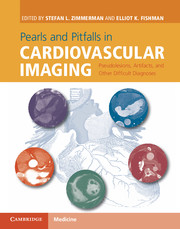 Pearls and Pitfalls in Cardiovascular Imaging
Pearls and Pitfalls in Cardiovascular Imaging from Section 7 - Acute aorta and aortic aneurysms
Published online by Cambridge University Press: 05 June 2015
Imaging description
The medial layer of the aorta expands in intramural hematoma (IMH) due to the accumulation of subacute blood products. The expansion can shear the wall of exiting arteries such as the intercostal and lumbar arteries.
Contrast collects between the sheared wall of the intercostal artery and the medial layer of the aorta. The contrast collection is beyond the confines of the arterial lumen but the pooled contrast is well localized (Figures 61.1 and 61. 2).
The shearing of the intercostal arteries is also called the “Chinese Ring Sword Sign”.
Importance
This entity can be confused for active extravasation.
In vascular imaging, active extravasation of contrast has important connotations. It means that there is active bleeding. The use of the present participle (bleeding) as opposed to the past tense (bled) elevates the clinical severity and urgency of the vascular process and the promptness with which corrective action is required. Both inappropriate usage and inappropriate non-usage of this term by imagers can have negative consequences.
Typical clinical scenario
Patient presents with chest or back pain with suspicion of an acute aortic syndrome.
Differential diagnosis
Active extravasation is inferred when there is contrast outside the confines of a vascular structure; the contrast outline does not conform to the shape of an arterial branch of venous tributary. Typically the contrast progressively pools in the arterial and venous phases of acquisition.
The pooled contrast can mimic false lumen of a dissection. It can also mimic a penetrating atherosclerotic ulcer.
Teaching point
Mistaking the pooled contrast from sheared vessels for active bleeding can lead to inappropriate operative intervention. IMH of the descending aorta is typically managed medically.
To save this book to your Kindle, first ensure no-reply@cambridge.org is added to your Approved Personal Document E-mail List under your Personal Document Settings on the Manage Your Content and Devices page of your Amazon account. Then enter the ‘name’ part of your Kindle email address below. Find out more about saving to your Kindle.
Note you can select to save to either the @free.kindle.com or @kindle.com variations. ‘@free.kindle.com’ emails are free but can only be saved to your device when it is connected to wi-fi. ‘@kindle.com’ emails can be delivered even when you are not connected to wi-fi, but note that service fees apply.
Find out more about the Kindle Personal Document Service.
To save content items to your account, please confirm that you agree to abide by our usage policies. If this is the first time you use this feature, you will be asked to authorise Cambridge Core to connect with your account. Find out more about saving content to Dropbox.
To save content items to your account, please confirm that you agree to abide by our usage policies. If this is the first time you use this feature, you will be asked to authorise Cambridge Core to connect with your account. Find out more about saving content to Google Drive.